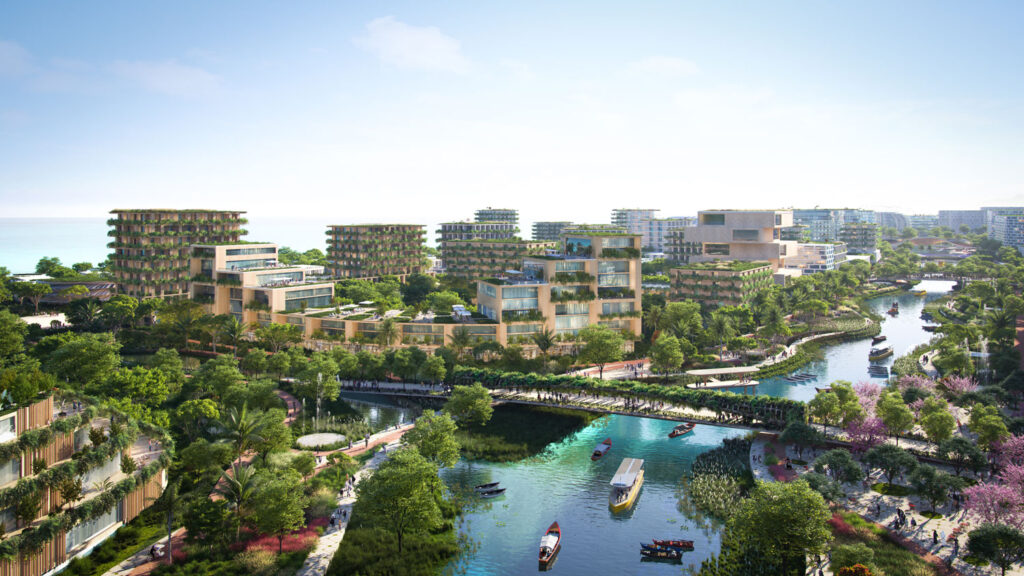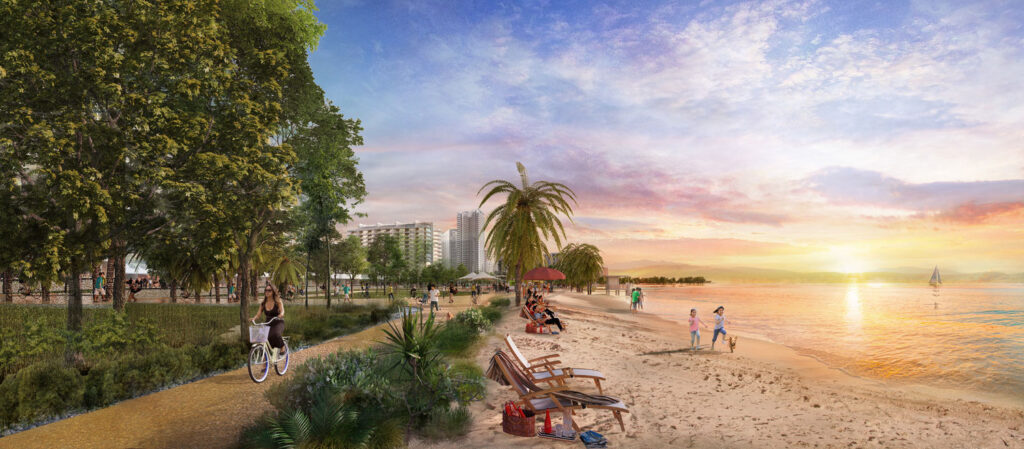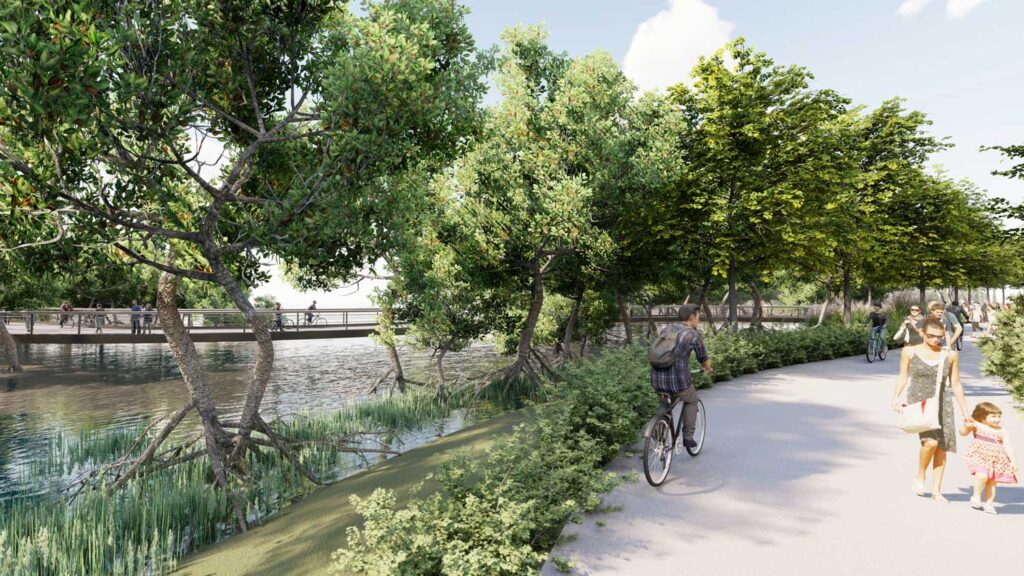Giving pulse to Silicon Island

The first island from PSI will have a purpose-built city to achieve Penang’s growth goals
The emerging Island A in Penang South Islands (PSI) is a greenfield that holds many possibilities as an outstanding place to live and work in.
Girded by best practices for environmental, social and governance (ESG) considerations, PSI is envisioned to be a climate-resilient place anchored by cutting edge industries and enterprises, and supported by infrastructure for seamless journeys amid open spaces.
Dubbed Silicon Island, the first island to emerge from the Penang South Reclamation project will immediately carve its mark on the regional stage, as the place to be for the electrical and electronics (E&E) industry.
Just like New York’s financial district and Los Angeles’ Hollywood, Silicon Island (also known as Island A) will be carefully curated from the start, instead of being allowed to evolve organically as it is designed as a place to secure Penang’s future as a high-tech manufacturing hub to complement the rest of the country’s industrial landscape.
Having a purpose-built city to achieve Penang’s growth goals, which complements the Penang2030 Vision, is not a theoretical or academic exercise, as it has roots in other interactive and inspiring spaces such as the 2,400ha Sophia Antipolis in France, the Brainport Eindhoven in the Netherlands, and Singapore’s Jurong Innovation District.
All these cities make for good examples of how industrial and technology cities understand that human capital is what makes a tech-based city successful – with talents automatically attracted to an outstandingly built environment at the right location.

According to Zairil Khir Johari, state executive councillor for infrastructure and transport, Penang must chart its own path by creating its niche as nations and regions compete for investments and tourist dollars.
“The PSI is the catalyst for Penang’s socio-economic growth in the next 50 years and beyond. Its role is not simply to expand the existing industrial sector but also to create a climate-resilient township for Penangites to live, work, do business, and raise their families.
“As everyone knows, Penang’s success today as the one of the most developed cities in Malaysia and the state with the highest GDP per capita outside of Kuala Lumpur is largely due to our industrial sector.
“For us to grow this sector, both in terms of scale by attracting even more investors, as well as in terms of value by attracting more advanced industries with higher paying jobs, it is pivotal for us to provide an ESG-compliant industrial park.
“Don’t forget what happened to Dyson’s Malaysian supplier when ESG non-compliance saw them losing their lucrative contract with the British giant,” Zairil said, adding that its proximity to the mature E&E ecosystem in Bayan Lepas, as well as the Penang International Airport, are already huge plus points.
World-class public space
All developments on Silicon Island will be subject to the Urban Design Guideline to help curate things in the right direction, in order that the place will present a good balance between hard structures – and all these meant for nature to establish itself.
“Every square inch of PSI is curated with environmental and social benefits in mind. For example, 20% or 182ha (450 acres) of Island A’s 931ha (2,300 acres) is reserved for green spaces such as public parks, water canals, wetlands, floodplains and bioswales which will promote biodiversity.
“Island A will have its own 20-acre mangrove area, creating new marine habitat for fishes and prawn.

“The PSI will also deploy artificial reefs and fish aggregating devices and build eco-shorelines at the islands’ perimeter – contributing to the sustainability of coastal fisheries,” Zairil added.
As user experience with public spaces determine one’s daily experience in cities, good planning of these spaces will be of paramount importance on Silicon Island as it will make or break the emerging city’s success in drawing talents, investments and visitors.
In a global competition organised by the state, Denmark-based Bjarke Ingels Group (BIG) emerged as the lead masterplanner for the development that will eventually have three islands.
Silicon Island will aim high, with BIG founder and creative director Bjarke Ingels saying that they had “set the bar as high as humanly possible by imagining a new archipelago that aims to be more culturally and biologically diverse than existing conditions.”
Green spaces and biodiversity
As far as Silicon Island is concerned, wide open green areas are the norm, not the exception. First, there is a network of coastal parks that are fully accessible to the public. These consist of a mixture of public beaches and esplanades that are designed as recreational and family-friendly public gathering spaces.
In addition to improving air quality and helping to ease tropical daytime temperatures, vegetation has the power to humanise cities by attracting people to outdoor activities.
As cities become denser, access to green public spaces will become even more important as urban forestation can lower stress levels and enhance well-being by moderating the urban heat island effect.
The 3km (60m-wide) stretch of new sandy public beaches is an integral part of Silicon Island, with this public beach forming the largest public leisure and recreational space for the island.

Equipped with multiple activity zones ranging from cycling tracks, jogging paths, playgrounds, to outdoor gyms, just to name a few, this beach is also expected to be a venue for water sports along the promenade.
The 5km long (40m-wide) esplanade runs continuously alongside the marine waterfront with the Heart of the Island (HOTI) as the focal point of the island. It is activated with vibrant waterfronts, piers with F&B and tourist activities. Set to be a world-class waterfront destination, it is also designed for large scale festive events and public gatherings.
Biodiversity-wise, the developer of Silicon Island will put in a 40m-wide mangrove wetlands –widely held to be even more effective at carbon sequestration than any other forest – at several coastal corridors to promote biodiversity conservation and mitigate any possible shoreline erosion.
Collectively, the 4km-long mangrove habitat will yield 8.1ha of sanctuary to nurture marine biodiversity, especially for species that use mangroves as nurseries.
Aside from the environmental benefits and shoreline protection, the mangrove habitat also provides an alternative nature-based recreation zone.
Enterprises and tenant mix
Diversity in green, open spaces is not an end itself, but also serves to enhance the overall quality of life on Silicon Island, even for those who commute in to work daily, other than tourists.
Silicon Island is not about creating high-end homes for the elites. Its diversity contains a good mix of residential units, offices, hotels, and commercial areas, including restaurants, cafes and local commerce that not only attracts people, but makes the overall environment friendlier.
The diversity of uses generates external activities that contribute to continuous buzz and vibrancy of the place, and this is most evident at the HOTI, which is where all best parts of island-living converge and are amplified.
With land size measuring approximately 65 hectares, HOTI features The Bay as the central focal attraction for locals and tourists alike – keeping the place alive as it also hosts a variety of businesses in the central business district that is interspersed with leisure, entertainment, retail, F&B outlets, and medical centres.
Island with a heart
Further lending vibrancy to the HOTI will be many tourism-related components, each featuring its distinct programming. These include the Fisherman’s Wharf & Market Place – a venue to cater to the meetings, incentives, conventions, and exhibitions (MICE) industry, as well as medical centres.
Incidentally, the Fishermen’s Wharf is one of the most visible demonstrations of offering a slice of the economic pie to local fishermen as they are allowed to sell their fresh catch as well as to serve cooked seafood on Silicon Island.
Collectively measuring at 182ha (450 acres), The Bay at HOTI, public beaches and mangrove wetlands, constitute the largest green and connected network in Penang state, with many of these areas accessible by the public.
Within the inner island lies the Central Canal, surrounded by 81ha (200 acres) of parks and waterway inspired by the iconic waterways of Amsterdam and London’s Regent Canal.

The value of this waterway network goes way beyond mere aesthetics and landscaping, as the battery-powered water taxis plying them will be seamlessly integrated with other modes of green mobility throughout the island to serve both residential enclaves and commercial precincts, including those adjacent to Silicon Island.
Designed to integrate with the bicycle path network, Silicon Island will be a place where bicycles and other eco-friendly transport modes take precedence over private cars.
The very design of the Central Canal and bicycle path network is key to ensuring an island-wide transportation plan that is compatible with environmental, social and governance frameworks to ensure climate resilience.
HOTI also functions as a transit hub that provides seamless connectivity via water taxis, electric trams, and Penang’s first LRT – supported by an extensive bicycle networks and walkways to ensure a truly “first mile-last mile” connectivity.
This car-lite approach offers a tranquil experience not found in other places of the country, and a journey with surprising twists and turns at every corner as explorers discover the various intricacies of each scenic corner of the island.
Quality spaces
With marine waterfronts, sheltered waterways, and an extensive green mobility network, HOTI provides an unparalleled opportunity in creating iconic spaces that benefit everyone in the vicinity – for both residents and visitors alike.
As both global and local talents are finicky and sometimes demanding when it comes to their choice of living, working and recreational space, all subsequent developments on Silicon Island will be guided by the need to have the buildings to maximise their interaction with the outdoor elements to encourages an interplay between the public spaces and recreational enclaves.
On Silicon Island, public areas will follow the principles of “complete streets and shared spaces” intended to ensure the safe passage of all users – pedestrians, cyclists, drivers and users of public transport.
To make this happen, there will be generous sidewalks, quirky but functional street furniture, and the provision of corners to host activities that contribute to the island’s vibrancy, whether these are pop-up stalls, food trucks, or artistic installations.
“We are serious about promoting the interaction between people and the environment, generate positive use of space, and uphold urban vitality, so that Silicon Island will be a cut above the rest in the brutal competition for investments, talents, and tourism dollars,” said Zairil.

